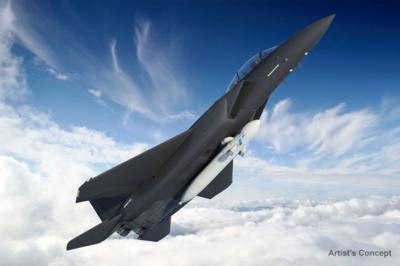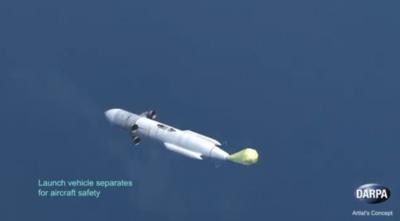Progress On Several Potentially Breakthrough Technologies Could Pave The Way For Much Cheaper, Faster And Easier Small-Satellite Launches
Through its Airborne Launch Assist Space Access (ALASA) program, DARPA has been developing new concepts and architectures to get small satellites into orbit more economically on short notice. Bradford Tousley, director of DARPA’s Tactical Technology Office, provided an update on ALASA at the 18th Annual FAA Commercial Space Transportation Conference in Washington, D.C. Tousley discussed several key accomplishments of the program to date, including successful completion of Phase 1 design, selection of the Boeing Company as prime contractor for Phase 2 of the program, which includes conducting 12 orbital test launches of an integrated prototype system.

“We’ve made good progress so far toward ALASA’s ambitious goal of propelling 100-pound satellites into low Earth orbit (LEO) within 24 hours of call-up, all for less than $1 million per launch,” Tousley said. “We’re moving ahead with rigorous testing of new technologies that we hope one day could enable revolutionary satellite launch systems that provide more affordable, routine and reliable access to space.”
Launches of satellites for the Department of Defense (DoD) or other government agencies require scheduling years in advance for the few available slots at the nation's limited number of launch locations. This slow, expensive process is causing a bottleneck in placing essential space assets in orbit. The current ALASA design envisions launching a low-cost, expendable launch vehicle from conventional aircraft. Serving as a reusable first stage, the plane would fly to high altitude and release the launch vehicle, which would carry the payload to the desired location.
“ALASA seeks to overcome the limitations of current launch systems by streamlining design and manufacturing and leveraging the flexibility and re-usability of an air-launched system,” said Mitchell Burnside Clapp, DARPA program manager for ALASA. “We envision an alternative to ride-sharing for satellites that enables satellite owners to launch payloads from any location into orbits of their choosing, on schedules of their choosing, on a launch vehicle designed specifically for small payloads.”
ALASA had a successful Phase 1, which resulted in three viable system designs. In March 2014, DARPA awarded Boeing the prime contract for Phase 2 of ALASA.
Because reducing cost per flight to $1 million presents such a challenge, DARPA is attacking the cost equation on multiple fronts. The Phase 2 design incorporates commercial-grade avionics and advanced composite structures. Perhaps the most daring technology ALASA seeks to implement is a new high-energy monopropellant, which aims to combine fuel and oxidizer into a single liquid. If successful, the monopropellant would enable simpler designs and reduced manufacturing and operation costs compared to traditional designs that use two liquids, such as liquid hydrogen and liquid oxygen.
ALASA also aims to reduce infrastructure costs by using runways instead of fixed vertical launch sites, automating operations and avoiding unnecessary services. Phase 1 of the program advanced toward that goal by making progress on three breakthrough enabling technologies:
- Mission-planning software that would streamline current processes for satellite launches
- Space-based telemetry that would use existing satellites instead of ground-based facilities to monitor the ALASA vehicle
- Automatic flight-termination systems that would assess real-time conditions during flight and end it if necessary

DARPA plans to continue developing these capabilities in Phase 2 and, once they’re sufficiently mature, intends to eventually transition them to government and/or commercial partners for wider use in the space community.
Pending successful testing of the new monopropellant, the program plan includes 12 orbital launches to test the integrated ALASA prototype system. Currently, DARPA plans to conduct the first ALASA flight demonstration test in late 2015 and the first orbital launch test in the first half of 2016. Depending on test results, the program would conduct up to 11 further demonstration launches through summer 2016.
If successful, ALASA would provide convenient, cost-effective launch capabilities for the growing government and commercial markets for small satellites. “Small satellites in the ALASA payload class represent the fastest-growing segment of the space launch market, and DARPA expects this growth trend to continue as small satellites become increasingly more capable,” Burnside Clapp said. “The small-satellite community is excited about having dedicated launch opportunities, and there should be no difficulty finding useful payloads.”
(DARPA Images)
 ANN's Daily Aero-Term (04.25.24): Airport Rotating Beacon
ANN's Daily Aero-Term (04.25.24): Airport Rotating Beacon ANN's Daily Aero-Linx (04.25.24)
ANN's Daily Aero-Linx (04.25.24) Klyde Morris (04.22.24)
Klyde Morris (04.22.24) Airborne 04.24.24: INTEGRAL E, Elixir USA, M700 RVSM
Airborne 04.24.24: INTEGRAL E, Elixir USA, M700 RVSM Airborne 04.22.24: Rotor X Worsens, Airport Fees 4 FNB?, USMC Drone Pilot
Airborne 04.22.24: Rotor X Worsens, Airport Fees 4 FNB?, USMC Drone Pilot




